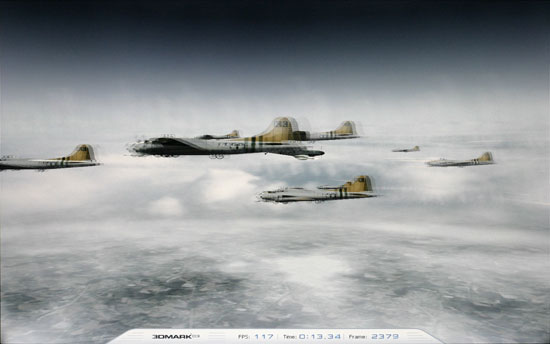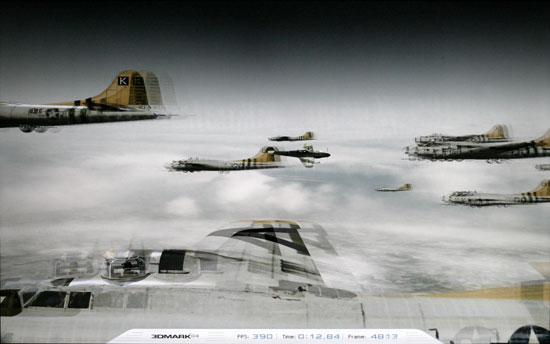Laptop LCD Roundup: Road Warriors Deserve Better
by Jarred Walton on May 22, 2007 5:00 AM EST- Posted in
- Displays
Response Times
Another topic that almost always comes up with LCDs is their response times, especially when compared to CRTs. Of course, on notebook computers technologies like CRTs are not a viable option - not unless you want to haul around one of those old 40 pound Compaq boxes with a 4" display that hides behind the fold down keyboard? (Ed: ah, those were good times!) While even the best desktop LCDs still exhibit some slight pixel smearing, the vast majority of users are okay with the level of performance now available. Considering that laptops now seem to be lagging behind desktops by a couple years in terms of quality and features, though, how do the laptop LCDs fare?
Since we were unable to send the same image simultaneously to multiple laptop displays, we resorted to simply taking pictures of a familiar scene from 3DMark03. We used the first game test in part because it has higher contrast images that make the frame transitions more visible, but also because at least one of the laptops struggled to get above 60 frames per second even at seriously reduced resolution and quality settings. (We ran the MSI at 640x400 rather than the native 1280x800 because the IGP would otherwise average in the low teens on frame rates, resulting in overlapping frames. The other laptops were run at their native resolutions and experienced no difficulties with this rather old benchmark.) We took numerous pictures on each laptop, and then selected one that seemed to best represent the performance. Here are the images we captured:
We couldn't find any manufacturer specifications suggesting what sort of response times we should be experiencing with any of these laptops, but judging by the above images we would venture to say that a rating of 25ms or lower would be appropriate. You can clearly see at least three frames on every one of the laptops, sometimes more. The A8Js and XPS M1710 both show four frames, although at least one of the frames is barely visible on each laptop. Since we also have to account for shutter lag on the camera, we would say that these two laptops appear to take around two frame updates resulting in an approximate response time of 33ms. The G2P and S271 on the other hand appear to take somewhere between one and two frame updates, giving them a response time of between 16ms and 33ms.
Considering that some of these notebooks really won't be used for gaming anyway (particularly the MSI S271), response time is not necessarily a critical factor. However, we certainly wish an "extreme gaming" laptop like the Dell XPS M1710 could provide better response times, and more importantly better overall display quality.
Another topic that almost always comes up with LCDs is their response times, especially when compared to CRTs. Of course, on notebook computers technologies like CRTs are not a viable option - not unless you want to haul around one of those old 40 pound Compaq boxes with a 4" display that hides behind the fold down keyboard? (Ed: ah, those were good times!) While even the best desktop LCDs still exhibit some slight pixel smearing, the vast majority of users are okay with the level of performance now available. Considering that laptops now seem to be lagging behind desktops by a couple years in terms of quality and features, though, how do the laptop LCDs fare?
Since we were unable to send the same image simultaneously to multiple laptop displays, we resorted to simply taking pictures of a familiar scene from 3DMark03. We used the first game test in part because it has higher contrast images that make the frame transitions more visible, but also because at least one of the laptops struggled to get above 60 frames per second even at seriously reduced resolution and quality settings. (We ran the MSI at 640x400 rather than the native 1280x800 because the IGP would otherwise average in the low teens on frame rates, resulting in overlapping frames. The other laptops were run at their native resolutions and experienced no difficulties with this rather old benchmark.) We took numerous pictures on each laptop, and then selected one that seemed to best represent the performance. Here are the images we captured:
 ASUS A8Js  ASUS G2P  Dell XPS M1710  MSI S271 |
| Click to enlarge |
We couldn't find any manufacturer specifications suggesting what sort of response times we should be experiencing with any of these laptops, but judging by the above images we would venture to say that a rating of 25ms or lower would be appropriate. You can clearly see at least three frames on every one of the laptops, sometimes more. The A8Js and XPS M1710 both show four frames, although at least one of the frames is barely visible on each laptop. Since we also have to account for shutter lag on the camera, we would say that these two laptops appear to take around two frame updates resulting in an approximate response time of 33ms. The G2P and S271 on the other hand appear to take somewhere between one and two frame updates, giving them a response time of between 16ms and 33ms.
Considering that some of these notebooks really won't be used for gaming anyway (particularly the MSI S271), response time is not necessarily a critical factor. However, we certainly wish an "extreme gaming" laptop like the Dell XPS M1710 could provide better response times, and more importantly better overall display quality.










55 Comments
View All Comments
Myrandex - Tuesday, May 22, 2007 - link
I am not all that opposed to lower resolution screens when it comes to a laptop. Laptop video chipsets are often times slow enough as it is, and when my 7200 G0 64MB (256MB TC) is attempted to be used for gaming, 1280x800 gives a much better experience then some 1980x1600 breatly resolution.MrPickins - Tuesday, May 22, 2007 - link
4 screens, and not a single one a 15" model? How does that constitute a "roundup"?This article needs far more models tested to be worthwhile.
JarredWalton - Tuesday, May 22, 2007 - link
It's a roundup of what we have right now. I have some 15" laptops coming for review, and if this wasn't made clear we will be performing these same tests on all future laptop reviews. This was just a way to jump start things before the laptops we currently have are sent back.MrPickins - Tuesday, May 22, 2007 - link
Don't get me wrong, I like the article's intent, and the tests run. I just feel it would have been better to wait and give a large comparison all at one time, rather than piecemeal.EarthsDM - Tuesday, May 22, 2007 - link
Great article. If you guys wouldn't mind, could you do these tests to the MacBook and MacBook Pro? In light of this new lawsuit (see below) I'd like to know how good my MacBook Pro's display is, i.e. 6-bit or 8-bit. Thanks!http://arstechnica.com/journals/apple.ars/2007/05/...">http://arstechnica.com/journals/apple.a...it-over-...
http://www.appledefects.com/?p=282">http://www.appledefects.com/?p=282
heulenwolf - Tuesday, May 22, 2007 - link
Great job on the article. I had no idea the G2P's display was so demonstrably superior to the competition. I'd be interested to see these tests performed with two more variables:1) How do screen options within a single laptop model score? For example, if you get a Dell Inspiron with the default screen vs the upsell for the "Ultrasharp" model. Such a comparison could also give you two systems that are alike in every other way so you could discern the impact of the "better" screen on battery life
2) I always hear about how Macs are better for multimedia applications. Does the colorimeter and software work with Macs, as well? If so, I'd be interested to see whether their color accuracy is truly better than those of competing laptops.
strikeback03 - Tuesday, May 22, 2007 - link
I'd assume you could test the colorimeter on a Mac running Windows, shouldn't affect the screen quality.bldckstark - Wednesday, May 23, 2007 - link
Apparently recent testing on the Mac's have shown that the display performs better under Windows than OSx. This is one of the reasons they are being sued right now for claiming better visual representation than "regular" notebooks, when they appear to be the same as all the rest.I don't know anyone who has a Macbook, Pro or not so I have not seen this.
I have been on the edge of buying a Macbook for some time, but when push came to shove, I bought a Lenovo. It is hard to find someone (now I am sure millions will reply since I said this) that thinks the other manufacturers are even in the same league as IBM was. So far Lenovo has been doing a good job of keeping the Thinkpad up to snuff, so I couldn't reasonably spend my money on something I had never seen before and had no consistency in manufacturing from one model to the other. Besides, there is that keyboard 8^)
jelifah - Tuesday, May 22, 2007 - link
This article was TREMENDOUSLY helpful. As most laptops are bought online it is impossible to be able to determine what an LCD looks like, short of going to a company's kiosk.Please continue to do reviews like this.
mostlyprudent - Tuesday, May 22, 2007 - link
Agreed. It's about time someone included one of the most important part of a laptop in the review process. I also appreciated the comparison to desktop LCDs. I have been sticking with my CRT, in part, because of the stark difference in viewing quality between my laptop and desktop PCs.